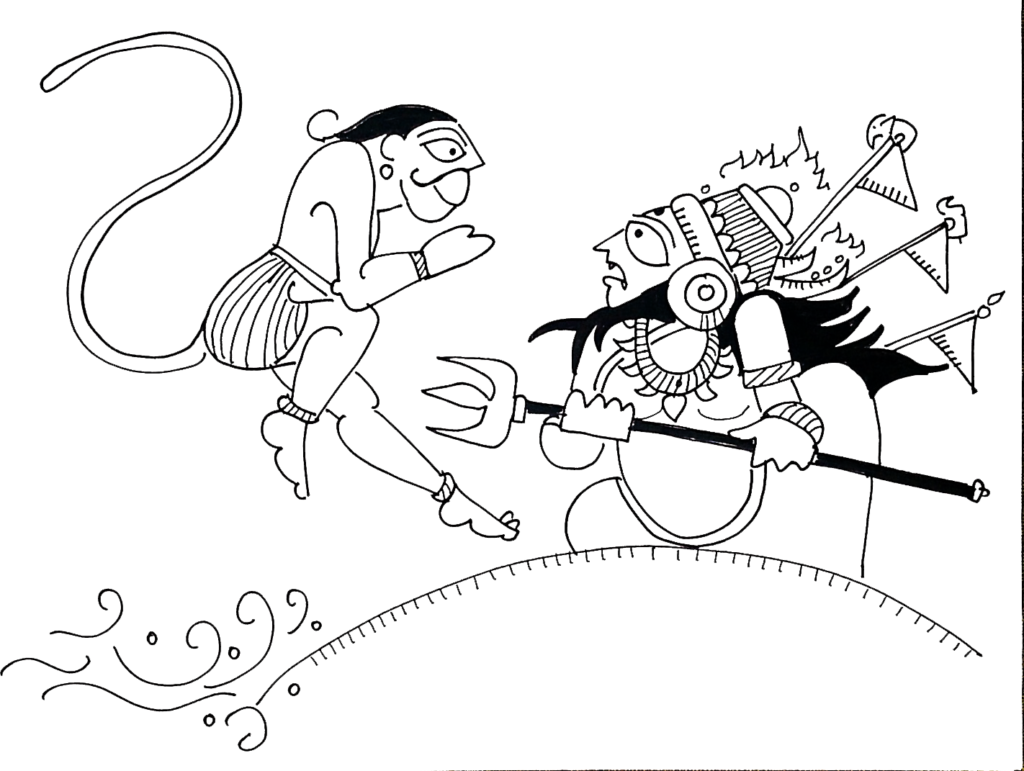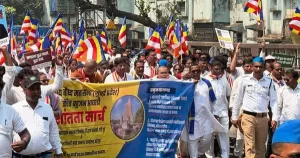Hindutva brigade keeps insisting it is the sole representative of Hinduism in the world, while it keeps promoting only Hindi, a north Indian language. Hence, a bill that aims to enable the equality of women in Indian politics is given a Hindi name, the Nari Shakti Vandan Abhinayam (or the Women’s Reservation Bill, 2023).
But typically, it becomes patronising as the bill is presented as an obeisance (vandan) to women’s power (nari shakti). That this obeisance will be given a few years later, not immediately, reveals the cynical nature of the bill.
Those promoting this bill are Hindi-speaking men who joyfully heckle Tamil female parliamentarians, on camera. This draws attention to an old divide, amplified since the 19th century—north Indian men are seen as followers of the Aryan Ram, and south Indian women are seen as the Dravidian king Ravana’s women.
Sanatani Hindutva’s Ram is always visualised alone, as a warrior, never as husband or lover, brother, son or father. Hindutva’s Hanuman, Krishna and Shiva are also visualised alone, in an aggressive stance. Women are shown as Durga, again a warrior, again alone. Bharat Mata is also alone, with a lion and weapons. God is male here and if not male, certainly violent. To justify the violence, the victims have to be evil or unjust or barbaric. That’s the job of the media, to project all victims as villains, deserving of violence. Ravana is then seen as a villain, but the problem is that he is also a Brahmin, and since the 19th century, a Dravidian. And he is surrounded by women who fight for him.
Hindutva considers the Ramayana as its holiest book and tries hard to project this as the Hindu Bible, though it often concedes to the Bhagavad Gita. The Gita is a prelude to a battle between men—the Pandavas and the Kauravas. The Ramayana is also projected as a battle between men—Ram and Ravana. Women here play a subordinate role; the victim—Sita of the Ramayana, Draupadi of the Mahabharata. It’s the role that women are relegated to in the Hindutva version of the Ramayana. In doing so, we forget the other warrior-women we encounter in the epic, at least four of them, who are on Ravana’s side, defending him.
The first is Tadaka (or Tataka). When Ram is a student, he is invited to the forest by Vishwamitra to protect the sages from savages who inhabit the woods. Here, Ram encounters a female warrior called Tadaka and is asked by his teacher to shoot her down. He hesitates because killing a woman is considered the worst of crimes, as bad as killing a Brahmin. But the teacher says that at this point she is the enemy, a predator, and her gender should not be considered.
Later in the epic, when Hanuman is flying over the sea to Lanka in search of Sita, his path is blocked by three warrior women. The first is Surasa, a monster who demands that Hanuman enter her mouth if he wishes to pass by her. Hanuman increases his size so that Surasa has to widen her jaw and then suddenly in a flash, he transforms into a tiny fly and moves in and out of Surasa’s mouth before she can snap it shut. He thus fulfils her condition, outwits her, and moves on, winning her admiration.
Hanuman then encounters Simhika, who captures him by his shadow and swallows him, but then Hanuman rips her stomach apart and comes out.
And finally on the shores of Lanka he encounters Lankini, the goddess who guards the city of Lanka, a great fight follows in which Lankini is defeated. And thus we see Hanuman triumphing over three female spirits—Surasa, Simhika and Lankini—in order to enter Ravana’s domain. These three are the female guardians of Lanka.
In other Southeast Asian Ramayanas, we encounter other women who fight on behalf of Ravana. There is Benjkaya, a sorceress, who pretends to be Sita’s corpse and seeks to demotivate Ram. But Hanuman throws her in the fire and she reveals her true self. There is also Suvarnamatsya, a mermaid, who tries to break Ram’s bridge. Hanuman enchants the mermaid (Hanuman of Southeast Asia is not a brahmachari) and convinces her to support Ram. In art, Hanuman is often shown trampling a woman, holding her hair. The woman is described as Panauti or the malevolent astrological force associated with misfortune, delay and procrastination.
Violence against women is a recurring theme in the Ramayana. We can argue these women are evil, adharmic, monsters, or simply savages, to justify this violence. But the story could have been told by making them all male. Why were they made female specifically? Was it to show the triumphal march of Aryan patriarchy? The Vedic hymns were primarily chanted by men for male gods and transmitted from father to son. Examples of female rishis and female deities in Vedic literature are more of an exception than the rule. In fact, the earliest reference to a man killing a female ‘demon’ comes from the late Vedic literature, where Indra’s friend Kutsa sexually enchants and enables the killing of Dirghajihvi, the long-tongued one, who licks the pot of Soma reserved for the gods.
In the Adbhut Ramayan, composed about 500 years ago, we hear the story of how Ayodhya is attacked by a demon with a thousand heads. Sita takes the form of Kali and defeats this demon, and then declares that she could have killed Ravana of her own accord, but allowed Ram to do so to proclaim the glory of Ram. She let him take charge. She is as powerful and does not need protection. Is the offering of ‘vandan’ then a patriarchal apology? We never hear Hindutva paraphrase what Sulabha told Janaka in the Mahabharata: the soul is genderless and only the flesh has a gender.
(Devdutt Pattanaik writes on relevance of mythology in modern times, especially in areas of management, governance and leadership. He defines mythology as cultural truths revealed through stories, symbols and rituals. Courtesy: Devdutt Pattanaik’s blog.)




